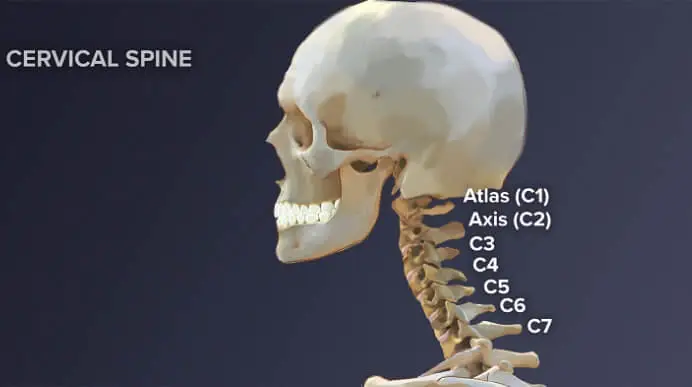The cervical spine comprises seven vertebrae located at the base of the skull. Its primary functions include supporting the skull, facilitating various head movements (such as tilting and turning), and protecting the spinal cord. The upper portion of the cervical spine includes the first two vertebrae, C1 and C2, while the lower portion consists of vertebrae C3 through C7. These vertebrae connect to the thoracic spine, working together to maintain head stability.

The C7 Cervical Vertebrae: Key Functions and Importance
The C7 vertebra, located at the bottom of the cervical spine, serves as the transitional point between the neck and thoracic region. It is crucial for providing stability and support to the spine and acts as a key connection between the head and the body. The health of the C7 vertebra is essential for normal neck movement, nerve transmission, and overall bodily function.
Exploring the Consequences of C7 Vertebra Damage
Understanding the potential outcomes of C7 vertebra damage is vital for enhancing spinal health awareness. This section explores common symptoms, possible causes, and the impacts of C7 vertebra damage.

Symptoms of C7 Vertebra Injury
Damage to the C7 vertebra can cause various symptoms, which may vary in severity based on the injury’s nature and extent. Common symptoms include:
- Neck Pain: Persistent or intermittent pain in the neck, sometimes radiating to the shoulders or arms.
- Localized Tenderness: Sensitivity and tenderness in the area of the C7 vertebra.
- Shoulder and Upper Limb Numbness or Tingling: Impaired sensation in the shoulders, arms, or fingers due to C7 vertebra issues.
- Muscle Weakness: Weakness or impaired movement in surrounding muscles due to compromised nerve transmission.
These symptoms can significantly impact daily activities and quality of life.
Causes of C7 Vertebra Damage
C7 Cervical Vertebrae: Various factors can lead to damage to the C7 vertebra, including:
- Trauma: Accidents, falls, sports injuries, or vehicular accidents can cause fractures or damage.
- Degenerative Changes: Aging-related changes such as osteophyte formation or disc protrusion.
- Postural Issues: Poor posture, such as forward head posture from excessive smartphone or computer use.
- Diseases: Conditions like osteoporosis, cervical degenerative diseases, or cervical disc herniation.
Identifying these causes is crucial for timely diagnosis and effective treatment.
Impacts of C7 Vertebra Damage

Physiological Effects
C7 Cervical Vertebrae: Damage to the C7 vertebra can affect body function in several ways:
- Neck Function: Pain and tenderness may limit neck movement, impacting activities like turning or lifting the head.
- Shoulder and Upper Limb Function: Damage can lead to abnormal sensations or muscle weakness in the shoulders and upper limbs, affecting strength and motor skills.
- Nervous System Function: Compression of surrounding nerves can lead to numbness, tingling, or abnormal sensations, potentially causing paralysis in severe cases.
Psychological Effects
C7 vertebra damage can also affect mental health:
- C7 Cervical Vertebrae :
- Pain and Discomfort: Persistent pain may lead to anxiety, depression, or mood changes.
- Activity Limitations: Reduced ability to perform daily activities can cause frustration and impact social, familial, and occupational roles.
Early diagnosis and comprehensive treatment, including medication, physical therapy, rehabilitation, and psychological support, are essential for improving patient outcomes.
Introduction to Forethought’s Spinal Assessment Products
Forethought offers advanced spinal assessment products with the following features:
- High-Precision Image Acquisition: Advanced techniques for accurate spinal imaging, including X-rays, CT scans, and MRIs.
- Intelligent Analysis Algorithms: Rapid and accurate analysis of spinal image data to identify issues and abnormalities.
- Customized Assessment Reports: Detailed reports that present spinal health status and provide evidence-based treatment recommendations.
- User-Friendly Interface: Simple and intuitive interface for ease of use across medical institutions.

Usage: Medical professionals upload spinal image data to our system, which automatically analyzes and generates reports. This allows for precise diagnosis and personalized treatment plans.
参考文献
- “Overview of the Cervical Spine,” National Institutes of Health – ソースを見る
- “Cervical Vertebrae and Their Functions,” Mayo Clinic – ソースを見る
- “C7 Vertebra and Its Role in Spinal Health,” Cleveland Clinic – ソースを見る
- “Understanding Cervical Spine Injuries,” American Association of Neurological Surgeons – ソースを見る
- “Causes and Symptoms of C7 Vertebra Damage,” Spine Health – ソースを見る

